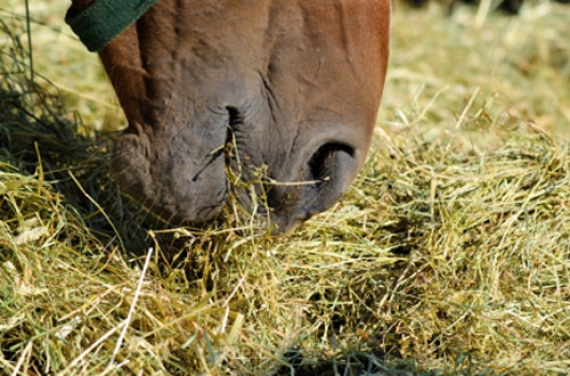Choosing Hay
When choosing hay for your horse:
- It’s what’s inside that counts. Ask that one or several bales are opened so you can evaluate the hay inside. Do not worry about slight discoloration on the outside, especially in stacked hay.
- Choose hay that is as fine-stemmed, green and leafy as possible, and is soft to the touch.
- Avoid hay that is over-cured, excessively sun-bleached or smells moldy, musty, dusty or fermented.
- Select hay that has been harvested when the plants are in early bloom for legume hay, or before seed heads have formed in grasses. Examine the leaves, stems and flowers or seed pods to determine the level of maturity.
- Avoid hay that contains significant amounts of weeds, dirt, trash or debris.
- Examine hay for signs of insect infestation or disease. Be especially careful to check for blister beetles in alfalfa.
- Reject bales that seem excessively heavy for their size or feel warm to the touch, as they could contain excess moisture that could cause mold, or worse, spontaneous combustion.
- When possible, purchase and feed hay within a year of harvest to preserve its nutritional value.
- Store hay in a dry, sheltered area out of the rain, snow and sun, or cover in the stack to protect it from the elements.
- When buying in quantity, have the hay analyzed by a certified forage laboratory to determine its actual nutrient content.
High-quality hay can be an important source of essential nutrients in your horse’s diet. A horse’s protein and energy requirements depend on age, stage of development, metabolism and workload. A mature horse will eat 2% to 2.5% of its body weight a day. For optimum health, nutritionists recommend that at least half of this should be roughage such as hay. For a 1,000-pound horse, that means at least 10 pounds of roughage each day.
Hay generally falls into one of two categories: grasses or legumes. Legume hay is higher in protein, energy, calcium and Vitamin A than grass hays. While hay alone may not meet the total dietary requirements of young, growing horses or those used for high levels of performance, high-quality hay may supply ample nutrition for less active adult horses.
Remember that horses at different ages and stages of growth, development and activity have different dietary requirements. Consult your veterinarian or a qualified equine nutritionist when formulating your horse’s ration. He or she can help you put together a balanced diet that is safe, nutritious and cost-effective.
For more information, visit the American Association of Equine Practitioners.




